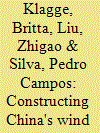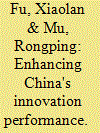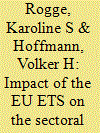|
|
|
Sort Order |
|
|
|
Items / Page
|
|
|
|
|
|
|
| Srl | Item |
| 1 |
ID:
116722


|
|
|
|
|
| Publication |
2012.
|
| Summary/Abstract |
The rapid rise of China as the largest wind energy market worldwide with several global leaders in turbine manufacturing received much attention from both scholarly and policy-analytical work. However, little attention has been given to the innovation activities of the Chinese wind industry. In our paper, we aim to address this gap, based on second-hand sources and over 50 personal interviews with wind energy-related experts. We argue that China's wind industry has made great progress in terms of manufacturing and installing, but is confronted with various challenges and problems regarding the development of its indigenous innovation capabilities. Using innovation systems approaches as an analytical tool and focusing on institutions, actors, technology and their interaction in supporting innovation activities, we decompose the elements of China's wind energy innovation system and their role in developing the domestic wind industry. Against this backdrop we identify and discuss challenges and obstacles in the development of an innovation-driven wind industry in China. The paper strongly argues that more attention should be paid to improve the coordination and cooperation among the various actors of the wind energy innovation system, to the build-up of a market-oriented education and training system as well as to intellectual property protection.
|
|
|
|
|
|
|
|
|
|
|
|
|
|
|
|
| 2 |
ID:
130980


|
|
|
|
|
| Publication |
2014.
|
| Summary/Abstract |
Transforming China into an innovation-driven economy has been one of the top priorities of the Chinese Government. This paper examines the policy choices involved in the extended national innovation performance framework for creating an open innovation system. Innovation capabilities, incentives and institutional frameworks are examined. The paper argues that China should continue to increase its investment in R&D and in education, and that there should also be an attempt to strengthen the incentive system at the macro, meso and micro levels. This strengthening may include reforms to: release the power of competition and guide resources towards innovative sectors; adopt appropriate human resource management, such as appraisal and remuneration systems; create effective policies for research funding management; and evaluate the efficiency of research to encourage the creativity of researchers, managers and employees. The paper also discusses the space for industrial policy in the 21st century.
|
|
|
|
|
|
|
|
|
|
|
|
|
|
|
|
| 3 |
ID:
101458


|
|
|
|
|
| Publication |
2010.
|
| Summary/Abstract |
This paper provides an overview of early changes in the sectoral innovation system for power generation technologies which have been triggered by the European Emission Trading System (EU ETS). Based on a broad definition of the sector, our research analyses the impact of the EU ETS on the four building blocks 'knowledge and technologies', 'actors and networks', 'institutions', and 'demand' by combining two streams of literature, namely systems of innovation and environmental economics. Our analysis for Germany is based on 42 exploratory interviews with experts in the field of the EU ETS, the power sector, and technological innovation. We find that the EU ETS mainly affects the rate and direction of technological change of power generation technologies within the large-scale, coal-based power generation technological regime, to which carbon capture technologies are added as a new technological trajectory. While this impact can be interpreted as the defensive behaviour of incumbents, the observed changes should not be underestimated. We argue that the EU ETS' impact on corporate CO2 culture and routines may prepare the ground for the transition to a low-carbon sectoral innovation system for power generation technologies.
|
|
|
|
|
|
|
|
|
|
|
|
|
|
|
|
| 4 |
ID:
124892


|
|
|
|
|
| Publication |
2013.
|
| Summary/Abstract |
Many studies raise doubts about the effectiveness of the institutions, programmes and instruments that shape the Chinese national innovation system. This article scrutinizes central-local interactions in the national Torch Programme that has governed a large group of high-technology zones since 1988. The Torch Programme's procedural practices challenge widely shared assumptions about the dirigiste character of Chinese innovation policy. It combines centralized definition of programme objectives with extensive local implementation experiments. As three case studies demonstrate, bottom-up policy innovations are effectively fed back into national programme adjustments and into horizontal policy diffusion. The array of organizational patterns and promotional instruments that emerges from competitive "experimentation under the shadow of hierarchy" (ESH) goes way beyond what could have been initiated from top down. We hypothesize that the procedural strengths displayed in the Torch Programme may provide better indicators of future innovative potential in China's high-technology zones than retrospective statistical indices and benchmarks that are derived from OECD experience.
|
|
|
|
|
|
|
|
|
|
|
|
|
|
|
|
| 5 |
ID:
113147


|
|
|
|
|
| Publication |
2012.
|
| Summary/Abstract |
The innovation system has interrelated components of invention, translation, adoption, and diffusion. Energy technology innovation has lagged that in other domains, and there is a compelling public interest in picking up the pace through appropriate government action. Government and universities are creating new approaches in the invention and translation stages. The Department of Energy (DOE) has implemented novel programs such as ARPA-E. Research universities have moved closer to the marketplace through more diversified industry collaboration models, such as convening research-sponsoring companies both horizontally in a sector and vertically across the innovation chain. Much more needs to be done to expand public-private partnerships and to define a broadly accepted government role in the adoption and diffusion stages. An administration-wide Quadrennial Energy Review process, informed by technical analysis and social science research, offers the best opportunity in this regard.
|
|
|
|
|
|
|
|
|
|
|
|
|
|
|
|
| 6 |
ID:
175014


|
|
|
|
|
| Summary/Abstract |
There is growing recognition that financing low-carbon energy and environmental transitions will require the innovation of new financial products. Yet current understanding of the conditions under which environment-focused financial innovations emerge and diffuse remains limited. This paper seeks to narrow this gap. Novel to the literature, we conceptualise financial innovation by synthesising insights from several conceptual frameworks previously used to understand technological innovation and sustainability transitions. Empirically, the paper focuses on the case of green bonds, which have been deployed to (re)finance a wide range of energy- and environment-related projects. Our analysis is based on a combination of semi-structured interviews, document analysis and observations from conferences. We show that many of the same processes, influences and dynamics identified in technology-inspired frameworks have played an important role in the upwards innovation trajectory of green bonds. These include: the activities of various intermediaries and entrepreneurs; a set of largely self-reinforcing processes such as learning and legitimation; and wider contextual developments creating a more favourable selection environment for sustainability-themed, fixed-income financial products. Our analysis additionally suggests that the scaling-up of green bonds depended on the specific design and implementation of the product itself and the growing involvement of emerging economies on the supply-side.
|
|
|
|
|
|
|
|
|
|
|
|
|
|
|
|
|
|
|
|
|